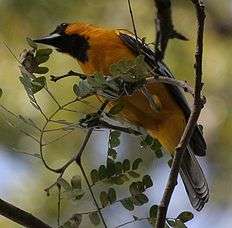New World oriole
| New World orioles | |
|---|---|
 | |
| Baltimore oriole, Icterus galbula | |
| Scientific classification | |
| Kingdom: | Animalia |
| Phylum: | Chordata |
| Class: | Aves |
| Order: | Passeriformes |
| Family: | Icteridae |
| Genus: | Icterus Brisson, 1760 |
| Species | |
|
25-30 species, see text | |
New World orioles are a group of birds in the genus Icterus of the blackbird family. Unrelated to Old World orioles of the family Oriolidae, they are strikingly similar in size, diet, behavior, and strongly contrasting plumage, a good example of convergent evolution. As a result, the two have been given the same vernacular name.
Males are typically black and vibrant yellow or orange with white markings, females and immature birds duller. They molt annually. New World orioles are generally slender with long tails and a pointed bill. They mainly eat insects, but also enjoy nectar and fruit. The nest is a woven, elongated pouch. Species nesting in areas with cold winters are strongly migratory, while subtropical and tropical species are more sedentary.
The name "oriole" was first recorded (in the Latin form oriolus) by Albertus Magnus in about 1250, which he stated to be onomatopoeic, from the song of the European golden oriole.
One of the species in the genus, Bahama oriole is critically endangered.
The genus Icterus was introduced by the French zoologist Mathurin Jacques Brisson in 1760 with the Venezuelan troupial as the type species.[1] The name is the Latin word for the Eurasian golden oriole.[2]
The genus name Icterus as used by classical authors, referred to a bird with yellow or green plumage. In modern times this has been identified as the golden oriole. Brisson re-applied the name to the New World birds because of their similarity in appearance.[3]
Species list
The genus contains 33 species.[4]
- Scott's oriole, Icterus parisorum
- Yellow-backed oriole, Icterus chrysater
- Audubon's oriole, Icterus graduacauda
- Jamaican oriole, Icterus leucopteryx
- Orange oriole, Icterus auratus
- Altamira oriole, Icterus gularis
- Yellow oriole, Icterus nigrogularis
- Bullock's oriole, Icterus bullockii
- Streak-backed oriole, Icterus pustulatus

- Black-backed oriole, Icterus abeillei
- Baltimore oriole, Icterus galbula
- Yellow-tailed oriole, Icterus mesomelas
- Spot-breasted oriole, Icterus pectoralis
- White-edged oriole, Icterus graceannae
- Campo troupial, Icterus jamacaii
- Venezuelan troupial, Icterus icterus
- Orange-backed troupial, Icterus croconotus
- Bar-winged oriole, Icterus maculialatus
- Black-vented oriole, Icterus wagleri
- Hooded oriole, Icterus cucullatus
- Black-cowled oriole, Icterus prosthemelas
- Orchard oriole, Icterus spurius
- Ochre oriole, Icterus fuertesi
- Cuban oriole, Icterus melanopsis
- Bahama oriole, Icterus northropi
- Martinique oriole, Icterus bonana
- Puerto Rican oriole, Icterus portoricensis
- Montserrat oriole, Icterus oberi
- Saint Lucia oriole, Icterus laudabilis
- Hispaniolan oriole, Icterus dominicensis
- Orange-crowned oriole, Icterus auricapillus
- Variable oriole, Icterus pyrrhopterus
- Epaulet oriole, Icterus cayanensis
References
- ↑ Brisson, Mathurin Jacques (1760). Ornithologie, ou, Méthode contenant la division des oiseaux en ordres, sections, genres, especes & leurs variétés (in French and Latin). Paris: Jean-Baptiste Bauche. Vol. 1 p. 30, Vol. 2 p. 85.
- ↑ Jobling, J.A. (2018). del Hoyo, J.; Elliott, A.; Sargatal, J.; Christie, D.A.; de Juana, E., eds. "Key to Scientific Names in Ornithology". Handbook of the Birds of the World Alive. Lynx Edicions. Retrieved 1 May 2018.
- ↑

- ↑ Gill, Frank; Donsker, David, eds. (2018). "Oropendolas, orioles, blackbirds". World Bird List Version 8.1. International Ornithologists' Union. Retrieved 1 May 2018.
External links
| Wikimedia Commons has media related to Icterus. |
- New World oriole videos, photos and sounds on the Internet Bird Collection